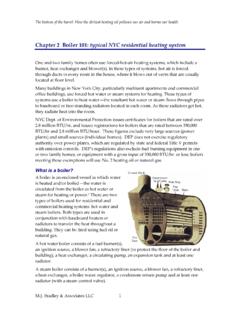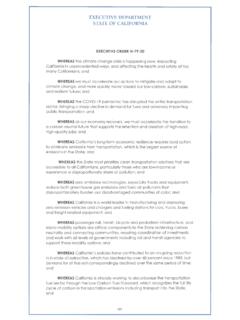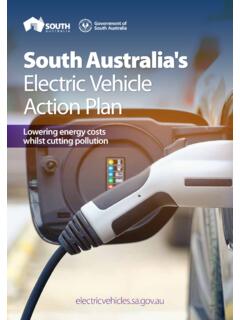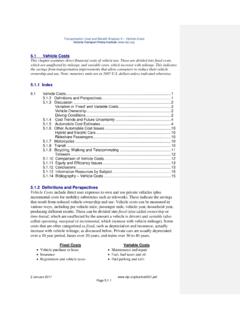Transcription of Medium- & Heavy-Duty Vehicles
1 Medium- & Heavy-Duty Vehicles market structure, Environmental Impact, and EV Readiness July 2021. Contents Executive Summary .. 4. M/HDV In-Use Fleet: vehicle Types & Uses .. 8. M/HDV In-Use Fleet: Environmental Impact .. 13. M/HDV EV market Readiness .. 16. Policy Implications .. 24. Appendix A Methodology & Data Sources .. 26. Appendix B Supplemental Information .. 37. References .. 40. 2. Acknowledgements Lead Authors: Dana Lowell and Jane Culkin This report summarizes an analysis of the medium and Heavy-Duty in-use truck fleet to identify the most common vehicle types/uses, estimate the environmental impact of each, and assess near-term readiness for greater adoption of electric Vehicles based on typical usage patterns and market status.
2 For this analysis we have included all Vehicles with gross vehicle weight rating (GVWR) above 8,500 pounds, encompassing vehicle classes from Class 2b (8,500 10,000 lb GVWR) to Class 8 (>33,000 lb GVWR). Totaling million Vehicles that annually travel more than 430 billion miles and consume more than 55 billion gallons of fuel, this is a very diverse group, ranging from Heavy-Duty pickups and vans to transit and school buses, freight and work trucks, and tractor-trailers. Most of these Vehicles are used commercially, rather than for personal transportation.
3 This report was developed by Bradley & Associates for the Environmental Defense Fund (EDF). About Bradley & Associates MJB&A, an ERM Group company, provides strategic consulting services to address energy and environmental issues for the private, public, and non-profit sectors. MJB&A creates value and addresses risks with a comprehensive approach to strategy and implementation, ensuring clients have timely access to information and the tools to use it to their advantage. Our approach fuses private sector strategy with public policy in air quality, energy, climate change, environmental markets, energy efficiency, renewable energy, transportation, and advanced technologies.
4 Our international client base includes electric and natural gas utilities, major transportation fleet operators, investors, clean technology firms, environmental groups and government agencies. Our seasoned team brings a multi-sector perspective, informed expertise, and creative solutions to each client, capitalizing on extensive experience in energy markets, environmental policy, law, engineering, economics and business. For more information we encourage you to visit our website, Bradley & Associates, an ERM Group company, 2021. For questions or comments, please contact: Dana Lowell Senior Vice President Bradley & Associates, LLC.
5 +1 978 369 5533. This report is available at 3. Executive Summary This report summarizes an analysis of the medium and Heavy-Duty (M/HD) in-use truck fleet to identify the most common vehicle types/uses, estimate the environmental impact of each, and assess readiness for greater adoption of zero emitting technologies over the next decade, based on typical usage patterns and market status. It is intended to help inform the Environmental Protection Agency's deliberations involving future criteria and greenhouse gas emissions standards and policies for medium- and Heavy-Duty engines and Vehicles .
6 This analysis focuses on prospects for electric vehicle penetration because all scenarios for avoidance of detrimental future climate warming point to the need for significant reductions in emissions from the transportation system, coupled with further decarbonization of the electric sector. Net reductions in transportation emissions could come from a range of zero -emitting vehicle types including battery- electric Vehicles and hydrogen fuel cell electric Vehicles . For this study, MJB&A evaluated the current state of battery electric Vehicles for each M/HDV market segment, to assess prospects for near-term (through 2025) and Medium- term (through 2030) uptake of zero -emission Vehicles within each segment.
7 While fuel cell Vehicles could also play a role in transforming the transportation system within this timeframe, the focus of this report on battery electric Vehicles is based on the relatively greater commercial maturity of this technology in the market Also, while comprising less than 10 percent of all Vehicles on the road, M/HD trucks account for more than 60 percent of tailpipe nitrogen oxide (NOx) and particulate (PM) emissions from the onroad fleet 1;. these emissions contribute to poor air quality in many urban areas, including areas with vulnerable populations.
8 Deploying zero -emitting Vehicles coupled with greater use of renewable electricity will provide significant public health benefits by reducing urban air pollution. A recent study indicates that eliminating tailpipe emissions from new medium- and Heavy-Duty Vehicles by 2040 could provide up to $485 billion in health and environmental benefits as a result of pollution reductions (2020$)2. For this analysis we have included all Vehicles with gross vehicle weight rating (GVWR) above 8,500. pounds, encompassing vehicle classes from Class 2b (8,500 10,000 lb GVWR) to Class 8 (>33,000 lb GVWR).
9 Totaling million Vehicles that annually travel more than 430 billion miles and consume more than 55 billion gallons of fuel, this is a very diverse group, ranging from Heavy-Duty pickups and vans to transit and school buses, freight and work trucks, and tractor-trailers. Most of these Vehicles are used commercially, rather than for personal transportation. While very diverse, approximately 80 percent of the fleet can be grouped into 17 market segments each with broadly similar vehicle configuration and usage patterns; these 17 market segments are the focus of this analysis3.
10 1. Per EPA MOVES model emissions inventory. 2. EDF, Clean Trucks, Clean Air, American Jobs, March 2021; 03 3. The remaining 20 percent of the fleet encompasses a wider diversity of vehicle types and uses, some of which includes a relatively small number of Vehicles . This includes Fire Trucks, ambulances and other emergency Vehicles , Motor Homes, and trucks used in Forestry and Mining. It also includes Vehicles that could not be classified based on VIN-defined vehicle type or the type of company that registered them. See Appendix A for more information about how the market segments were determined and number of Vehicles in each was estimated.
















